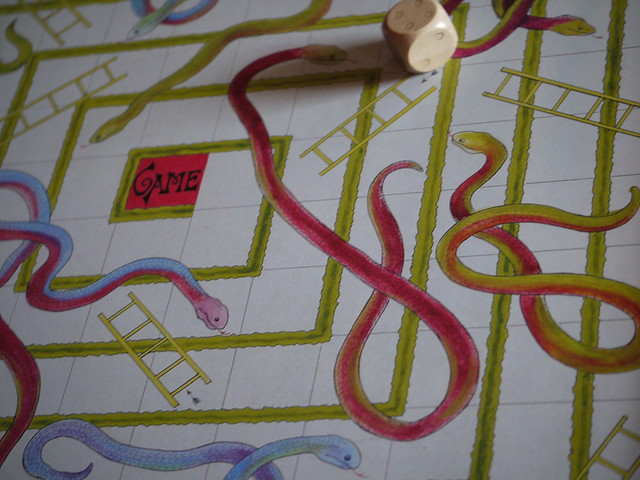 |
| I've never seen a spiral board... wow! |
 |
| Click for full size |
 The problem with race games is that many of them devolve into chutes and ladders (American; snakes and ladders elsewhere). This one definitely did. I thought a one die game might be easiest, and after some practice settled on moving 15º times the die roll. It included right angles and gave some nice opportunity for mental multiplication. I justified the simplicity of the game to myself by adding a game-design objective. The winner adds a rule; that rule has to help with the catch-up characteristic of the game.
The problem with race games is that many of them devolve into chutes and ladders (American; snakes and ladders elsewhere). This one definitely did. I thought a one die game might be easiest, and after some practice settled on moving 15º times the die roll. It included right angles and gave some nice opportunity for mental multiplication. I justified the simplicity of the game to myself by adding a game-design objective. The winner adds a rule; that rule has to help with the catch-up characteristic of the game.
In addition - since the game was simple - I wanted to have another option. I brought some triangle grid paper and an eightfold diagram (links to Google docs) to support the students in making an art project with rotational symmetry. As I told the students, math art is as close to my heart as math games. I explained how to color a piece and then imagine it turning, or on the 8-fold to color in 1, 2, or 4 wedges and then copy it.
The students gave the game a good try, and they seemed to meet many of the objectives quickly. Watching them play, the game seemed a bit too long. One student who had gotten disengaged was willing to collect data for me on how long a game took. His results: 27 turns for a full game. 16 turns for 1.5 loops shorter. After one try, some people played on, many moved on to the math art, and a few pulled out the games they made in December. Mr. Schiller and I agreed it was too long, though the class was just barely in favor of okay-as-is. In terms of new rules, some students modified it to have 2 dice. Others added rules for if you land on someone +15º, an "if ahead, out one loop line," a -30º spot and similar. Several students were proud to share their art. Not many tried the triangle paper except for making free designs.

A revised, shorter game is at the end of this post. In general, it was so-so. The whole experience really raised for me the question of how good does an educational game have to be. These students have played some really good games so far, and I think they were disappointed that this one was more regular. I've definitely thought that educational games have a lower bar, since you're not interested in replay on many of them once your objective is met. My experience has been that any sort of game is a welcome change. But maybe if games are regularly played, the bar rises. I'd be interested in your opinions below, by twitter or email.
In terms of the game design framework I've been trying, and my rating of Spiral:
- Goal(s) - good concrete objectives.
- Structure - the spiral really fit the objectives well.My main question here is if the board should have angle measures on it. (Definitely, if polar coordinates are the objective.)
- Strategy - no real strategy. Real room for improvement here.
- Interaction - with no choices the interaction is limited to the racing. It's a hook, but no way to effect your opponent.
- Surprise - not really relevant to this game.
- Catch-Up - this game has it, both through randomization of the die and the board structure; but it's of the candyland/chutes and ladders variety.
- Inertia - main reason for shortening the game. Overstayed it's welcomed. I think race games, in particular, probably need to be mindful of pace.
- Rules - clean, simple. The add-a-rule rule was a big hit. I'll be using that again.
- Context: Fun-Flavor-Hook. The spiral is a start to this, but some context for the spiral might have helped here. With all the spirals in nature, it shouldn't be too hard to add something. Maybe birds flying to the eye of a tornado? Hurricane?
The modified game is up at Google docs.
Snakes & Ladders Image: Smabs Sputzer @ Flickr








No comments:
Post a Comment